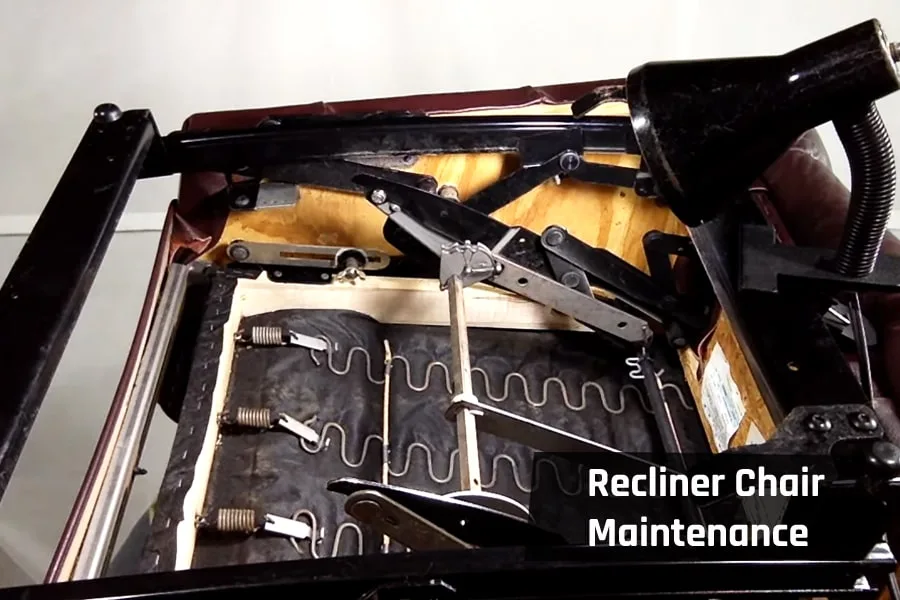The recliner stands out as the most cherished and coveted piece of furniture, especially following a taxing day at work. The unparalleled comfort provided by a reclining chair makes it a favorite.
Proper care for the recliner is essential to preserve its structural integrity, mechanical components, and upholstery. Efficient maintenance significantly extends the product’s lifespan, ensuring that the level of comfort it offers remains consistently high.
Key Takeaways:
- Proper care preserves structural integrity, mechanical components, and upholstery.
- Upholstery care involves dusting, vacuuming, and utilizing covers, with specific cleaning processes outlined.
- Maintain immediacy in cleaning spills, use cleaning products sparingly, and oil reclining parts for smooth operations.
Explore our curated list of top recliner chair maintenance and care tips. You’ll acquire a comprehensive understanding of these tips and tricks, applicable regardless of the size of your recliner chair.

Guide to Recliner Chair Maintenance
The primary driver of a recliner’s functionality is its metal activating mechanism, transforming an ordinary chair into a reclining haven. This crucial mechanism is secured in place using cables, screws, and nuts.
Regular greasing or oiling of the screws is essential to uphold tension and ensure the smooth operation of the reclining chair. When using the recliner, exercise caution in handling the cables to prevent potential damage, increasing the lifespan of your recliner.
How to Properly Lubricate Your Recliner Chair
- Step 01: Lay down a cloth to absorb spills and excess grease.
- Step 02: Flip the recliner to effectively lubricate the metal screws and nuts.
- Step 03: Apply the lubricating material, reaching all the metal parts with a sprayer.
- Step 04: Once done, return the recliner to its original position.
Recommended Lubricants for Your Recliner Chair:
- Furniture wax
- Grease
- Oil
- Silicone spray
Frequency of Lubrication
Regular lubrication is key to maintaining the tact of screws and nuts. A six-month interval between lubrication sessions is generally sufficient. Additionally, lubricate the recliner chair if you notice any creaking noises or experience changes in the tension of its parts. Otherwise, the recliner will not stay reclined.
How to Maintain Recliner Upholstery
The aesthetic appeal of the recliner is primarily dictated by its upholstery fabric, underscoring the importance of its care. Upholstery maintenance is a crucial aspect of preserving the recliner’s overall appearance.
Employing straightforward and swift techniques such as regular dusting, vacuuming, wet wiping, and the use of upholstery covers can significantly enhance the cleanliness of the upholstery.
Daily dusting, achieved with a soft cloth, is a simple yet effective practice. Vacuuming proves invaluable for eliminating deep-seated dust and debris within the upholstery.
For more challenging stains, wet wiping becomes a viable option. For pet owners, investing in pet-friendly covers is a wise choice.
Upholstery Cleaning Process – Step by Step
- Step 01: For leather recliners, create a 50/50 mixture of water and vinegar to wipe away stains.
- Step 02: Fabric upholstery can be cleaned using a mild detergent mixed with water. Opt for a stiff-bristled brush to tackle stains, steering clear of steel cleaners that may compromise the texture.
Recommended Cleaners for Upholstery
- Mild detergent
- Vinegar
- Lukewarm water
- Laundry detergent
How to Clean Your Cloth or Fabric Recliner
When it comes to cleaning your cloth or fabric recliner, The Mobility Furniture Company offers a comprehensive service. Simply reach out to our office, and our team will carefully assess the fabric’s instructions, providing you with precise cleaning guidance.
The choice of products for cleaning your cloth or fabric recliner depends on whether your material is solvent-safe or requires water-based cleaners exclusively.
Artificial fabrics like polyester, nylon, and acetate typically favor water-only solutions, while natural fibers such as cotton, linen, and velour generally tolerate solvents.
After vacuuming or wiping away dirt, dust, and crumbs, follow these steps according to your product’s care instructions:
How to Clean a Water-Safe Upholstered Recliner
- Step 01: Fill a bucket with warm water and add one to two tablespoons of liquid soap or mild laundry detergent.
- Step 02: Wet a cloth from the bucket, wringing out excess water. Thoroughly wipe the upholstery, using a brush to scrub out any stains or spots.
- Step 03: Rinse the cloth and wipe off any residual soap.
- Step 04: Absorb excess water with a towel and allow the chair to air-dry.
How to Clean a Solvent-Safe Upholstered Recliner
- Step 01: Spray the recliner with a solvent-based upholstery cleaner, letting it sit for the recommended time.
- Step 02: Use a stiff-bristled brush to scrub the recliner, removing stains or embedded dirt. Wipe away excess with a damp cloth.
How to Clean a Soft Leather Recliner
Cleaning a soft leather recliner is a straightforward process with various available products or the option to create your own solution.
Opt for a soap with a mild pH balance or make a mixture of equal parts water and white vinegar. Always conduct a test in a small, inconspicuous area to ensure there are no marks or discoloration.
Step-by-Step Guide
- Step 01: Use a soft damp cloth to gently but firmly rub the solution onto the chair, allowing it to dry.
- Step 02: Buff and polish the surface with another dry cloth, removing most of the product. No rinsing is necessary.
- Step 03: Treat the chair with a leather conditioner or wax once or twice a year to maintain suppleness and protect it from drying out or cracking.
How to Clean a Faux Leather Chair
Faux leathers, composed of materials like PVC, polyurethane, or polyamide microfiber, benefit from mild soap or detergent for cleaning. Conduct a spot test first to ensure compatibility.
Step-by-Step Guide
- Step 01: Create a solution with warm water and use a soft cloth to wipe it over the chair.
- Step 02: Dry the chair with another soft cloth; no rinsing is required.
- Step 03: Regularly apply a protective treatment to add a thin layer that repels stains and facilitates easier cleaning. Protect faux leather from drying out in direct sunlight by using a cover or closing curtains when not in use.
Cleaning the Headrest on a Recliner Chair
Certain chair parts, like the headrest and arms, are prone to stains from oil and product residue. Use washable covers for protection, or apply a protective treatment for leather or faux leather chairs.
If cleaning the headrest is necessary, follow the same method used for the rest of the chair, adhering to any instructions on the label. In cases of severe oil or grease stains, professional cleaning may be required.
6 Recliner Maintenance Tips for Prolonged Lifespan
Everyone wants to prolong their recliner chair life. Here are a few maintenance tips to give your recliner chair an upkeep for the lifetime.
Regular Dusting
Consistent dusting, ideally every other day, is a simple yet effective way to maintain your recliner’s material. This indirect buffing keeps the material shining, reducing the likelihood of the chair appearing aged.
Cloth-Wiping
Employing cloth-wiping complements dusting by removing dirt and small, removable stains that may persist. Choose soft or lint-free cloths based on your recliner’s material to prevent lint buildup in hard-to-reach areas.
Mid-Intensity Vacuum
Use a mid-intensity vacuum to reach nooks and crannies without risking damage to the material. Avoid aggressive scrubbing; instead, opt for a small-nozzle vacuum for areas with stubborn dirt and food particles.
Cleaning Products
Use cleaning products sparingly, around once a week or as needed for stains. Avoid detergents and similar products, consulting your supplier for safe options.
For leather recliners, opt for leather conditioners weekly to freshen up the chair and provide extra protection.
Immediacy Is Key
Act immediately when spills occur on your recliner. Swiftly wiping off stains prevents difficulty in removal and eliminates the risk of lingering traces. Maintaining immediacy is crucial for effective cleaning.
Oiling Reclining Parts
Refer to the chair’s instructions or maintenance manual to oil reclining mechanisms, particularly if they slow down over time.
Applying a small amount of oil can revive the mechanism, ensuring smoother reclining operations. If uncertain, seek directions from your supplier for proper oiling techniques.
Last Notes
To maximize the lifespan of your recliner, diligent maintenance and care are highly advised. For outdoor relaxation, consider investing in a weatherproof outdoor recliner.
The longevity of your recliner hinges on the meticulous upkeep of its individual parts, as each component plays a crucial role in its overall functionality. The provided guidance on recliner chair maintenance and care serves as valuable insight, ensuring your recliner remains in pristine condition.
